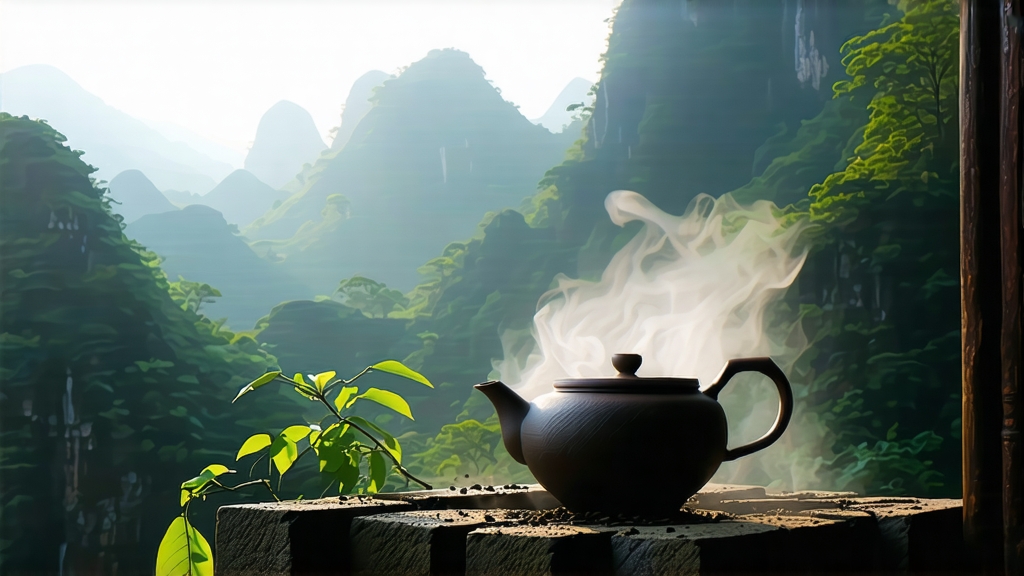
Tucked away in the humid, karst-pocked mountains of southern China’s Guangxi Zhuang Autonomous Region, Liu Bao tea has spent four centuries quietly perfecting the art of microbial alchemy. To most outsiders “dark tea” begins and ends with Yunnan’s Pu-erh, yet Liu Bao—older than many Pu-erh recipes—carries its own story of war caravans, maritime trade, and the elusive “betel-nut fragrance” that connoisseurs chase like perfume historians seeking a lost 19th-century cologne. This article invites the global tea traveler to discover why Liu Bao was once ballast in the holds of spice-bound junks, how a unique “wet piling” predating Pu-erh’s wo dui was born in wicker baskets, and the way a single 1980s brick can still echo with the taste of longan fruit and mahogany-paneled tea houses.
-
From Military March to Maritime Merchant
The name Liu Bao literally means “six fortresses,” a reference to the six stockades that guarded the mountain pass linking Guangxi’s Wuzhou to the Pearl River delta. During the Ming-Qing transition (mid-1600s) soldiers stationed there received compressed tea as rations because the tight bricks resisted mold on humid march routes. When peace returned, the same bricks rode bamboo rafts down the Xun River to Guangzhou and, eventually, to British clipper ships plying the South China Sea. Colonial invoices from 1848 list “Lew Pouw” (an early romanization) alongside cassia and star anise, proof that Liu Bao sailed west long before Pu-erh ever wrapped itself in neon marketing paper. -
Micro-terroirs within 30 km
Liu Bao is not a single-garden product; it is a protected geographical indication embracing several micro-climates inside Cangwu County. The classic “Zhenshan” (core mountain) zone sits at 300–500 m where red lateritic soil is laced with quartz; here, the cultivar Guilin #4 develops thick hypodermis cells that later feed fungi during wet piling. Further west, the “Dashan” (big mountain) zone harvests two weeks later, yielding broader leaves and a deeper amber liquor. A third, lower-elevation “Pingdi” (flatland) zone produces lighter, floral styles favored in Hong Kong dim-sum restaurants. Blenders marry all three to achieve the traditional “three heights, one fragrance” profile. -
Crafting the Darkness: Basket Fermentation
Unlike Pu-erh’s cement-floor wo dui, Liu Bao’s “wet piling” is still carried out in 45 kg bamboo baskets called long. After brief kill-green in a 200 °C wok, leaves are rolled on rattan mats, then piled while still 65 % moist inside the long. A linen cover traps heat; every 48 hours the pile is flipped by bare-handed “basket turners” who gauge temperature by pressing their forearms into the core—when the skin can tolerate five seconds, it is time to turn. Seven to ten cycles create a gentle, aerobic fermentation dominated by Aspergillus niger and Blastobotrys adeninivorans, microbes rare in Yunnan heaps. The result is a leaf that looks like burnt umber velvet and smells of damp driftwood and dried longan. -
Pressing, Curing, and the Secret Smoke
After fermentation the tea is sun-dried for only 40 minutes—just enough to drop moisture to 12 %. Traditionally it was then packed into 50 kg cane-wrapped baskets and transported on shoulder poles; the friction of bamboo strips against leaf exuded a microscopic sap that subtly smoked the tea during the week-long trek to market. Modern producers replicate this “road curing” by resting the loose tea in lightly toasted baskets for 30 days, turning it every three days. Finally the leaf is steam-softened and hydraulic-pressed into 250 g bricks, 500 g cakes, or 1 kg baskets, each wrapped in palm-leaf to allow continued micro-oxygenation. -
The Chemistry of Betel-Nut Aroma
Gas-chromatography studies at the Wuzhou Tea Research Station show that Liu Bao develops a unique trio of aroma compounds: 1) 1,2-dimethoxy-4-(2-propenyl)-benzene, responsible for the peppery top note; 2) β-ionone, lending violet